#Biblical Interpretation of Crucifixion
Text
Who Crucified Jesus?
The question is sometimes raised as to who crucified Jesus? According to Chafer, “Closely related to the contrast between the divine and human sides of Christ’s death, is the question: Who put Christ to death? As already indicated, the Scriptures assign both a human and a divine responsibility for Christ’s death.”[1] According to the testimony of Scripture, Jesus’ death on the cross was the…

View On WordPress
#A crucified Messiah#Atonement in Christian Theology#Biblical Accounts of Christ&039;s Crucifixion#Biblical Interpretation of Crucifixion#Biblical Poetry on Atonement#Christian Atonement Theories#Christian Poetry on the Crucifixion#Christian Salvation and Sin#Crucifixion of Jesus#Did Gentiles crucify Jesus#Did Jesus willingly go the cross?#Did Jews crucify Jesus#Did Romans crucify Jesus?#Did the Jews crucify their Messiah?#Divine and Human Responsibility in Christ&039;s Crucifixion#Divine Plan for Salvation#Free Will in Jesus&039; Sacrifice#Hypostatic Union of Christ#Jesus crucified#Jesus&039; Willing Sacrifice#Jewish and Roman Collaboration in Jesus&039; Crucifixion#Personal Reflection on Christ&039;s Sacrifice#redemption through Christ#Role of God the Father in Jesus&039; Death#Sacrificial Nature of Christ&039;s Death#Satan&039;s Influence in the Crucifixion#Satanic Influence in Scripture#The Cross in Christian Theology#The Messiah crucified#Theological Perspectives on Christ&039;s Death
1 note
·
View note
Video
youtube
Why Trump Is Partnering With Christian Nationalists
Donald Trump is portraying himself as a religious savior. He says Election Day will be: …”the most important day in the history of our country, and it’s going to be Christian Visibility Day.”
Trump has repeatedly compared his criminal trials to the crucifixion of Jesus, promoted videos calling his reelection “the most important moment in human history,” and that describe him as a divinely appointed ruler.
He claims to be a holy warrior against an imaginary attack on Christianity.
TRUMP: They want to tear down crosses//But no one will be touching the cross of Christ under the Trump administration. I swear to you.
He’s even selling his own version of the Bible.
Trump is playing to a rising white Christian Nationalist movement within the Republican Party.
Christian Nationalists believe that the law of the land is not the Constitution, but instead the law of God as they interpret it. Under this view, atheists and people of other faiths (including Christians of other denominations) are all second-class citizens.
Trump’s supporters are increasingly overt in their calls to replace democracy with a MAGA theocracy.
The idea that the will of voters is irrelevant because God has anointed Trump was a recurring message in the efforts to overturn the 2020 election.
In previous videos, I’ve highlighted how MAGA Republicans have embraced core elements of fascism. They reject democracy, stoke fear of immigrants and minorities, embrace a gender and ethnic hierarchy, and look to a strongman to lead and defend them.
The combination of fascism and Christian Nationalism is called Christofascism, a term first used half a century ago by the theologian Dorothee Sölle. Fascists rise to power by characterizing their opponents as subhuman. Christofascists take it a step further by casting opponents as not just subhuman, but actually demonic.
Framing opponents as enemies of God makes violence against them not only seem justifiable, but divinely sanctioned, and almost inevitable.
Christofascists want to strip away a wide range of rights Americans take for granted. Former Trump staffers involved in developing plans for a second Trump term have called for imposing “Biblical” tests on immigration, overturning marriage equality, and restricting contraception.
And MAGA-aligned judges are already setting their dogma ahead of the Constitution. In his concurring opinion on the case that declared frozen embryos are people, Alabama Supreme Court Justice Tom Parker cited God more than forty times and quoted the Book of Genesis and other religious texts.
Nothing could be more un-American than the Christian Nationalist vision. So many of America’s founders came here as refugees seeking religious freedom. The framers of the Constitution were adamant that religion had no role in our government. The words “God,” “Jesus,” and “Christ,” don’t appear anywhere in the Constitution. And the very first words of the Bill of Rights are a promise that “Congress shall make no law respecting an establishment of religion, or prohibiting the free exercise thereof.”
Christofascism, or any religion-based form of government, is a rejection of everything America has aspired to be — a secular, multi-racial society whose inhabitants have come from everywhere, bound together by a faith in equal opportunity, democracy, and the rule of law.
Beware.
502 notes
·
View notes
Text
honestly, I think there’s something really neat about easter and trans day of visibility coinciding on the same day this year. christians celebrate easter to commemorate jesus’ resurrection after the crucifixion, and the holiday is associated with life and rebirth. and I’m not trans, but I know a lot of trans people who use the theme of rebirth to express their own experiences with transitioning. there’s a shared theme of immense suffering followed by the joy of being born again. I think about how jesus was said to have shown the disciples the scars on his hands from the cross after being resurrected, and of the culture surrounding gender-affirming surgical scars in the trans community, and how scars are seen as a symbol of becoming someone new.
I was refreshing myself on the biblical passage (john 20:24- what a coincidence!) and was struck by this interpretation from the central congregational church:


I left organized religion a long time ago, but something about the fact that these two days coincide this year is really beautiful to me. happy easter and trans day of visibility to all who celebrate :)
114 notes
·
View notes
Text
Elle Argent as Jesus Christ: Heartstopper art analysis.

Yesterday, I made this post where I wordlessly compared Elle's art piece for the Lambert School to the painting that draws her attention at the Louvre, Caravaggio's Supper at Emmaus, a depiction of Jesus breaking bread for his disciples after his crucifixion and subsequent rising.

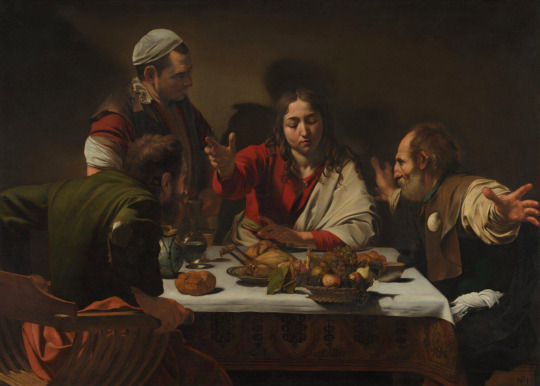
Elle's perspective on the painting / a full view of the painting (source)
The first thing I noticed that helped me draw the connection between these two paintings was their composition, the basic triangular lines that guide the eye in each painting; from Jesus and Elle in the center to the innkeeper and Tao at the top.
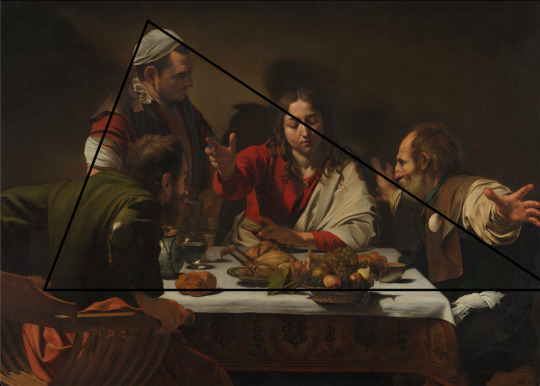

Heartstopper also clearly wanted us to make some connection between Elle and this Caravaggio: they focus on her face before they show us the painting, so we wonder what exactly it is she's seeing, which increases its narrative importance. I assumed she recognized herself in a painting; she did, but not in the way I expected.
The National Gallery (see above source) has this to say about the Caravaggio:
On the third day after the Crucifixion two of Jesus’s disciples were walking to Emmaus when they met the resurrected Christ. They failed to recognise him, but that evening at supper he ‘... took bread, and blessed it, and brake and gave to them. And their eyes were opened, and they knew him; and he vanished out of their sight’ (Luke 24: 30–31).
Painted at the height of Caravaggio’s fame, this is among his most impressive domestic religious pictures. He brilliantly captures the dramatic climax of the story, the moment when the disciples suddenly see what has been in front of them all along. Their actions convey their astonishment: one is about to leap out of his chair while the other throws out his arms in a gesture of disbelief. The stark lighting underlines the dramatic intensity of the scene.
Typically for Caravaggio, he has shown the disciples as ordinary working men, with bearded, lined faces and ragged clothes, in contrast to the youthful beardless Christ, who seems to have come from a different world.
Jesus, in the story, opens the eyes of his disciples in more ways than one (I pulled my Bible out for this!). First, in the scene depicted in the painting, the disciples do not know that this man is Jesus until he blesses the bread and breaks it for them, revealing himself as Christ. Second is the context in which Jesus comes to share dinner with his disciples: they meet him on the road during the day before, and he interprets the Old Testament for them: (stay with me I promise we'll leave the Biblical stuff and get back to the gay stuff soon)
Luke 24:13-16 Now on that same day two of [the disciples] were going to a village called Emmaus, about seven miles from Jerusalem, and talking with each other about all these things that had happened. While they were talking and discussing, Jesus himself came near and went with them, but their eyes were kept from recognizing him.
Luke 24:25-27 Then he said to them, "Oh, how foolish you are, and how slow of heart to believe all that the prophets have declared! Was it not necessary that the Messiah should suffer these things and then enter into his glory?" Then beginning with Moses and all the prophets, he interpreted to them the things about himself in all the scriptures.
If Safe Space is an exact analogue to Supper at Emmaus, then Elle takes the position of Jesus, and she draws from the story of Christ's crucifixion and rising a trans metaphor.
Death does not always mean death. For example, in the world of tarot, the card of Death does not signify literal Death, but a transformation: that the idea of death is a catalyst for change. If you're trans or non-binary, you understand the idea of the person you were being dead; that's why they call it a deadname. For me, the girl I was is dead. The person I am now, a living, breathing, non-binary person, is alive.
Jesus died and lived again; the boy Elle was died and the girl Elle is lived. Elle takes the spot of Jesus. Elle is risen.
There's another half to this metaphor: of the disciples that don't recognize Jesus. See where I'm going with this? At first, after Jesus had undergone his transformation, the disciples do not recognize him; literally "Their eyes were kept from recognizing him." The fault is not on them – it is another stronger force that maintains their blindness. But Jesus stays with them, despite the fact that they don't know who he is, and he talks to them about the scriptures.
We don't know much about Elle, pre-transition. But we know that Elle, Tao, and Charlie, at least, were friends before Elle's transition, and she had to come out to them at some point. So, in essence, she is Jesus on the road to Emmaus; unrecognized, a stranger, until she reveals herself for who she is.
She takes the moment Jesus tells his disciples who he is and shows what happens when Elle stays. We don't all have the luxury of being the Son of God, who can just pop away at a moment's notice after coming back from the dead (which is what he does, in the story: once the disciples have their eyes opened, he leaves). But this is Elle, out, resurrected, staying.
"So. There've been a lot of changes in my life over the last couple years. But with this piece I guess I wanted to capture a place that holds a lot of happy memories. Even in the darker times. Somewhere I always felt safe."
Safe Space comes after the moment of realization, after Elle comes out, after her friends' eyes are opened. But implied in its source and its inspiration is the moment of truth, the moment of coming out. There's been a lot of that, this season, coming out. There's people that want to and are scared, and people that refuse to and walk away. We never had to go on that journey with Elle. But she's telling us about it, now. She's telling us that it was glorious, that it was godly, that it was religious, that she died and was resurrected.
Before I leave, I want to touch on Tao's importance in this piece. The disciples in Supper are the two men that are seated; the man standing is the innkeeper, who is not quite a part of Jesus' world. Interesting, that Charlie and Isaac, the two people of Elle's group who are part of the queer community, take the place of the two disciples, and Tao, the token straight friend, is standing in the place of the innkeeper; not a follower of Jesus but a witness to the miracle of his resurrection anyway. They are all different people in this painting; different identities, different lives, different loves. But they were all there to witness Elle revealing herself in her resurrection. Tao, afraid of being left alone, is brought into this inner sanctum of Elle's world. Into her safe space.
#heartstopper#heartstopper spoilers#heartstopper analysis#heartstopper meta#elle argent#tao xu#charlie spring#isaac henderson#heartstopper season 2#my stuff#i am absolutely in love with this analysis#and i hope that everyone else likes it too!!!#userbarrow#userelletao
246 notes
·
View notes
Text
Thoughts on the Donquixote's crucifixion.
Since today is Good Friday I felt like sharing this piece of interpretation of Donquixote family's "crucifixion". Throughout the series and Doflamingo's life I think we can see some symbolism, paralelism, or just vague allusions and hints to his nature being similar to that of the Antichrist (opposite of Christ) or the idea of Doflamingo as Lucifer or a fallen angel (we see something akin to The Last Supper with his "family", including his own personal "Judas" sitting at his left; his ideology of being the rightful king to rule the world, yet not being willing to sacrifiece himself for anyone, but actually expecting everybody else to sacrifice themselves for him; his agent-of-chaos personality; the entire idea that he is almost a devine creature that fell from Heaven to Hell, stripped of his rightful power, status, and legitimate possition above humans, betrayed by his own family and blood; the nickname "Heavenly Demon", etc.). However, I believe the moment in his life he comes to incarnate all these topics comes just after his and his family's crucifixion, or just right after the very moment he lashes out against the rabbid mob awakening and loosing his haki. Just seconds before we have this image:
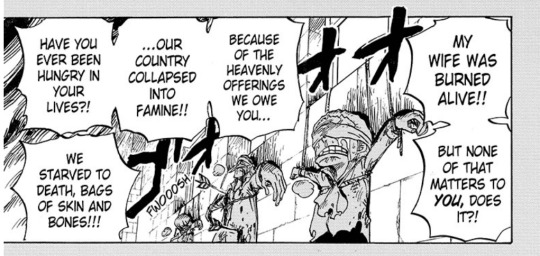
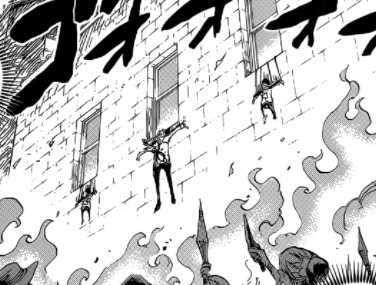
Here we have Homing, whom we know is a good man, in the middle, at the centre of the scene. Rocinante is to his right hand side, and Doflamingo is to his left. As you might know, Jesus Christ was crucified together with two more people, often refered to as the good thief (traditionally named Dimas/Dismas), and the bad thief (traditionally named Gestas). The good thief was crucified at the right hand side of Jesus, while the bad thief was cricified at his left. Maybe I am looking to much into it, and I'm pretty sure someone else must have already realised this, but I can't help to notice the paralelisms and similarities. In this scene, while all Homing is concerened with is the safety of his children and doesn't mind begging and humiliating himself to try to get the mob to free them, to the point he asks the enraged mob to forgive his children, for they were only little kids, Doflamingo's anger gets the best of him and he lashes out at the crowd, not asking nor begging them to put him down, but threatening to kill them all for their actions, all while blaming his father for all his surffering and his family tragic fate. No forgiveness, no acceptance, but defiance and a promise of vicious and bloody revenge for his father and the craze mob's wrong-doings. Homing was willing to take in all the hate, die for the sins his kind had committed over the centuries, if only to appease the mob and get them to spare his children. He was willing to die for them (and he eventually did, though not in the best way possible, tbh), he was a good person and this scene perfectly shows that, despite his naiveté and the tragic and dire consequences of his actions, he acted out of the goodness of his heart. Doflamingo would not even lower himself to the point of asking for mercy, not before humans he believed were below him.
We all know how the story goes, how Doflamingo and Rocinante turned out to be complete different people, with the whole good vs evil motive they have going on.
Again, I'm probably digging too much into it, but I just like the Rosi/Dismas, Doffy/Gestas and Homing/Christ paralelism. More so considering how Homing will eventually willingly die for his kids' future, which sounds kinda biblical given we are all God's sons and daughters, and he (Jesus, God's son, God himself) died for us (even if in Homing's case he did die for nothing, as Doffy will not be accepted back among his kind); and how, just after Homing's (Jesus) death, it will be Doffy who becomes, in a way, the symbol of the fallen angel, of the gone-wrong-Jesus, of the anti-Christ, almost Satan himself (ruling the underworld, as his father's heresy took the throne above away from him). He replaces his father as the semi-Biblical almost Christ-like figure, but in a reversed, twisted and sick way.
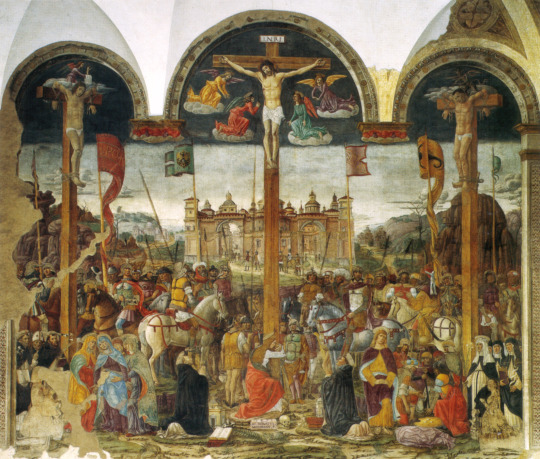
Crucifixion by Giovanni Donato
#doflamingo#doffy#homing#rosinante#donquixote doflamingo#donquixote rocinante#donquixote homing#donquixote family#one piece#headcanon#op headcanons#also#love the idea of Homing symbolising home#a home for rosi and doffy#and how doffy by killing him actually kills the only chance he got to find a home again#he'll never be accepted back by celestial dragons#he lost his brother with his murderous actions#his 'family' will never truly be 100% home to him#the guy he grew up with and was the closest with died#the brat he got obsessed with abandoned him and casued his downfall#he killed his only possibility to have a home a family when he killed his own father#too many tags#too many fantasy thoughts#none of this is canon lol
31 notes
·
View notes
Note
Jo, oh you my love who puts the Jo in joy.
Give me your top 5 pieces of visual art about death and/or mortality.
<3
Oh Somna, my Angel of darkness and despair. I wish that I could bring you to a museum and talk for hours about art history and interpretation and all of that. This is my interpretation of a lot of these and some are not as straight forward as you might think.

A Dead Soldier - 17th Century- Artist Currently Unknown I had a visceral reaction seeing this one in person in London a decade ago. I probably looked crazy but we’ve been thinking about the futility of war and human life forever. What is the use to be born and live a life only to die for some futile cause of a king or a government and in your death you are discarded. Forgotten. It’s especially meaningful that we don’t even know the artist now. Death comes for us all, and even your memory will die but your work might live on.
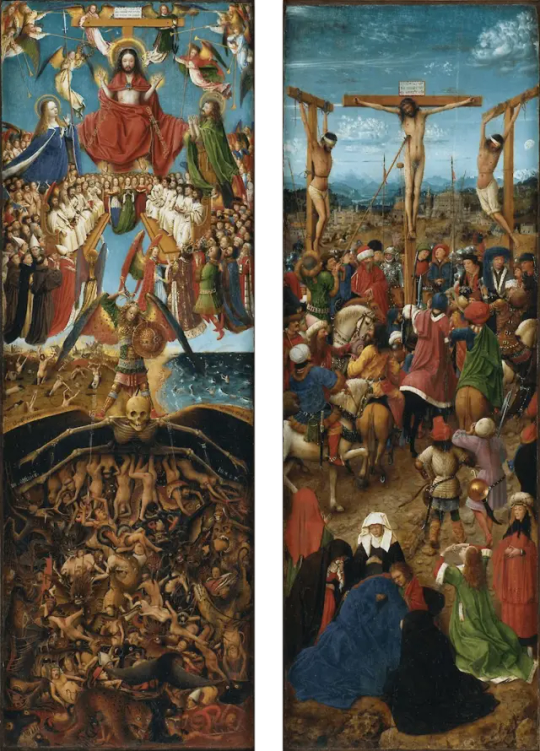
Crucifixion and Last Judgement - 15th Century - Van Eyck Ok this one less because of the biblical elements (I actually have a whole feeling about biblical depictions in art I could give a lecture) but because of use of color. IM SURE YOU KNOW PIGMENT ISNT CHEAP especially historically. That’s why prominent figures like Jesus and Virgin Mary and all of that are painted with vibrant colors to kind of show off their importance and the wealth of the patron. But. In this, all of the living people who came to witness the crucifixion in their colorful garb (ignore Mary in her blue, she’s special) and then the masses of people after the last judgement who are muddy and dull. But Jesus, Mary, John the Baptist all of these prominent celestial figures in color because of their importance. The contrast. In life you can have everything, but in death you become the dirt. Riches in life mean nothing. Your goodness/virtue is your wealth. I could SAY MORE. But I won’t.

Descent from a Cross - 17th Century- Rebrandt OK I AM A FORMER CATHOLIC Religious things appeal to me but once again less the religious and more the fact of Jesus surrounded by disciples in death. Being carried being lowered so carefully. Your memory, your lessons, your impact in life will be felt and carried onwards after you die. Who are you? But who are you to the people around you? Obituaries mean nothing. Everyone will remember Aunt What’s-her-face was a bitch.
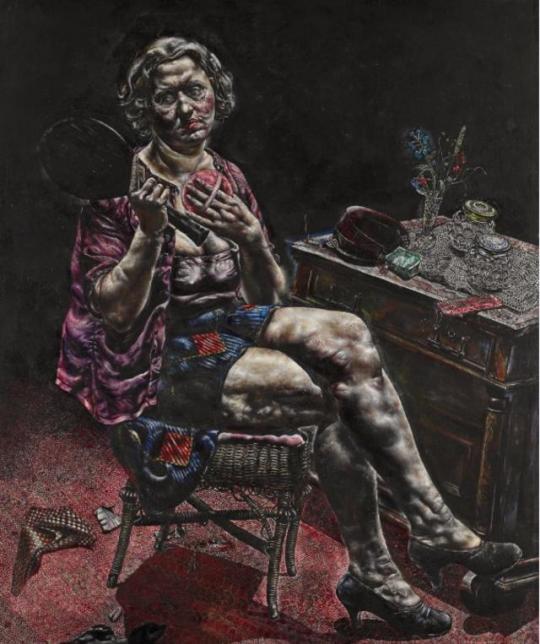
TBH ANYTHING BY IVAN ALBRIGHT I know that feels like a cop out. But all of his work makes me feel a certain way about life, not about death. How gross we are, how fragile we are. He has a lot that focuses on regrets. They’re all grotesque. The painting above was of Albright’s 19 year old neighbor who modeled and he chose to paint her as an old woman to say “here. Here is what you will become here is what we all become.” Cherish life, cherish youth, cherish beauty. Even if we all believe ourselves to be imperfect, time will only make us worse so choose to live peacefully and happily as possible.
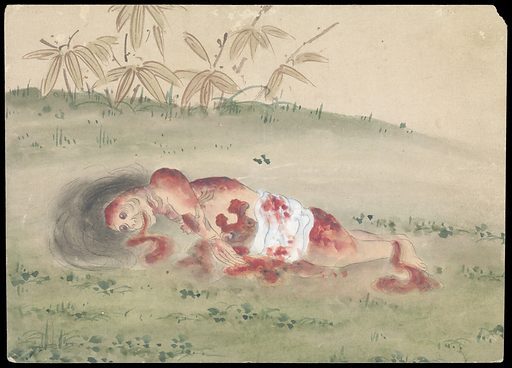
It’s not this piece but this piece is cool but there is a Japanese practice called Kusozu that depicts the stages of decay after a person dies. I’ve seen several sets of Kusozu art in person and just…it makes you feel something. It was after I saw it for the first time that I decided I didn’t want my body embalmed after I die. It’s a beautiful process, to have your body give back to the earth that made it be. There’s a scientific thing that’s like…well I guess it’s spontaneous combustion actually but all energy in the universe is finite. We’re not gonna get any more. A river pushes a boat, the energy of the movement of the water propels the boat forward. If the water is still, the boat is still. We die and then the energy, the atoms, the particles of us should go back to the earth. What happens when we pump a dead body with chemicals to prevent decay? Do we know? How can we know the effects on the earth? But a natural decay? We are the earth and the earth is us and a wolf can eat your liver and live on for another few days. You fertilize the soil and become the flowers.
Death is life. This was fun.
12 notes
·
View notes
Note
Hiiii🧚🏻♂️
Can u speak about asteroid lacrimosa? That intrigues me so much, I can't find almost any information. I also would love to know how it would work in synastry?
I also have lacrimosa in scorpio conjuct venus and conjuct rising in asc pc in capricorn, that could give me a nostalgic look? or suffered? people ask me if i'm ok all the time lol also have chiron conjunct asc so yea anyways?
thank u for read love your blog sorry for the lenght 🌨️
lacrimosa, our lady of sorrows - mother mary (asteroid 208)
hi, i won't be answering the aspects portion of this ask because i do not respond to asks regarding asteroids i have not covered out of fairness to others and to the asker (it is for the best that you see where i may draw from when doing interpretation). after reading the my interpretation of the myth and you are still interested in your prior question please resubmit your prior question/ask!
on to mary.
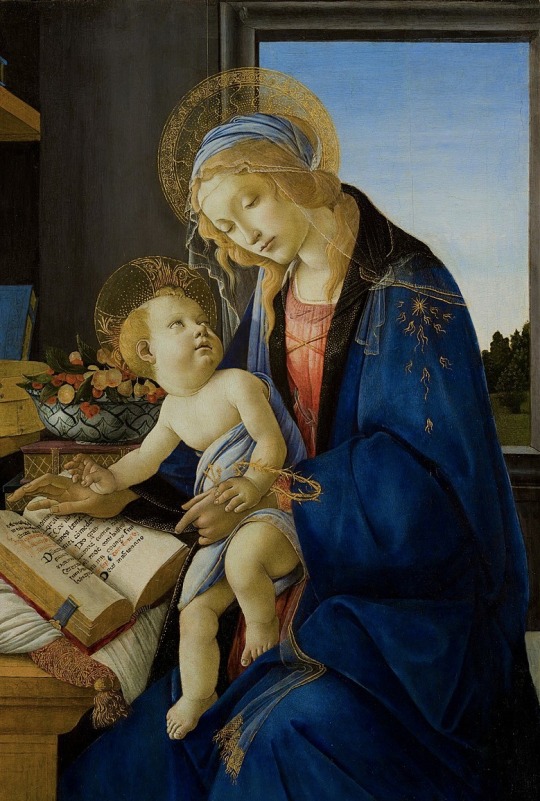
Lacrimosa, Latin for "weeping" or "teary," is most often linked to The Virgin Mary, or "The Lady of Sorrows." The appearance of the phase "Lacrimosa" is linked to the Roman Catholic Requiem sequence "Dies Irae": "Lacrimosa dies illa / Qua resurgent ex favilla / Judicandus homo reus. / Huic ergo parce, Deus: / Pie Jesu Domine / Dona his requiem. Amen." In English this roughly translates to: "Tearful is the day / When risen from ashes / Guilty men are to be judged. / Spare him, God: / Pious (righteous) Jesus / Grant them rest. Amen." As a mini crash course: Mary is Christian derived figure referred to as St. Mary, the Virgin Mary, Miriam, Maryam, second Eve, the immaculate one, etc. In the Biblical section the book of Luke, Mary is visited by an angel while she is engaged to be married to Joseph, who is a descendant of Abraham just like Mary herself. The angel tells Mary that God has favored her and she is to give birth to God's son, whose name will be Jesus. Mary was confused because she was a virgin - the angel stated that the Holy Spirit would be upon her. Mary told the angel that she was God's faith servant and that what the angel said would be divinely done to validate her understanding. When Mary informed Joseph that she was to have God's son he continued, as planned, to marry her because he too was a loyal servant of God. Mary would later travel to Bethlehem and give birth to Jesus. Mary and Joseph had many more children - Mary appears again in the Bible when Jesus performs His miracles and to witness His crucifixion. Which brings us back around to why is Mother Mary called "The Lady of Sorrows." Mary's title of "The Lady of Sorrows" comes from the moment of his death, as she is said to have faced intense suffering/grief during the passionate death of Jesus. IN MY OPINION Lacrimosa in your chart can represent a) where you experience heartbreak, b) where you grieve someone you look up to, c) where you are innocent and trusted with a divine purpose, and/or d) what your greatest sorrow is.

i encourage you to look into the aspects of lacrimosa along with the sign, degree, and house placement. for the more advanced astrologers, take a look at the persona chart of lacrimosa!
like what you read? leave a tip and state what post it is for! please use my "suggest a post topic" button if you want to see a specific post or mythical asteroid next!
click here for the masterlist
click here for more biblical myths & legends
want a personal reading? click here to check out my reading options and prices!
#astrology#astro community#astro chart#astro placements#asteroid astrology#asteroid#natal chart#persona chart#biblical#biblical mythology#christian bible#bible scripture#bible#lacrimosa#mother mary#asteroids#astrology notes#astroblr#astro content#astro notes#astro posts#astrology tumblr#asteroid208
45 notes
·
View notes
Text
Jedah and Judah / ジュダ
Jedah is one of the principal antagonists of Fire Emblem Gaiden and its remake Fire Emblem Echoes: Shadows of Valentia, serving as the high priest of the Duma Faithful. This localized name seemingly comes from the character Jedah Dohma, a powerful demon seeking even greater power from the Darkstalkers series produced by Capcom. This connection is strengthened by both Duma and Dohma being written the same in Japanese, ドーマ (rōmaji: dōma).
Judah is a Loptrian bishop sent from the Grannvale Empire to the Thracian Peninsula that guards Grutia Castle in Fire Emblem: Genealogy of the Holy War. His name, similar to Fire Emblem Gaiden's Gharn referencing Archanea's Dark Pontifex, is a nod to Jedah. After all, in Japanese they are both named ジュダ (rōmaji: juda). This name is almost certainly in reference to the Biblical figure of Judas Iscariot, whose name is typically written ユダ (rōmaji: yuda), derived from the more Hebrew-oriented rendering of Judah. Judas was one of the Twelve Apostles of Jesus Christ and served as their accountant. Of course, he is best known for his betrayal, selling out Jesus to the high priest Caiaphas for thirty pieces of silver. This leads to the crucifixion—something Judas either never intended or quickly felt guilty over. After his attempt to return the silver and release Jesus failed, he soon claimed his own life.
Due to his betrayal, Judas's name became a commonplace insult for one who has committed a betrayal or is untrustworthy. This is reflected in the game with Jedah's promises to Celica to save Mila—empty lies made to get Celica to cooperate and become willing to give her soul to Duma. One could also interpret Jedah as betraying the wishes of his god, as the War Father's desire to save the Earth Mother from her inevitable degeneration would be corrupted into a desire for Mila to be slain.
Given his position within the Duma Faithful, Jedah may be intended to combine the roles of both Judas Iscariot and the high priest Caiaphas. Caiaphas was cooperative with the Roman Empire, much like the Duma Faithful supported the Rigelian Empire. The relation between Rudolf and Jedah as emperor and advisor may be loosely based on that of Pontius Pilate, the governor of Judaea at the time of the crucifixion, and Caiaphas, who seemed to be a boon asset to the governor in his rule. After Judas sold out his master to the Jewish community seeking to defame who they believed to be a false messiah, Caiaphas held Jesus in trial, ending in a charge of blasphemy. Caiaphas seeks out Pontius Pilate, who held the authority to judge; he saw no reason to bring punishment upon Jesus, but offered the gathered crowd the choice between releasing Jesus and the known criminal Barabbas. A near-unanimous call for Barabbas' freedom followed, and Jesus would be sentenced to death.
This parallel between fictional and biblical high priests is further bolstered by the role of Celica: though she is not sentenced to death, Jedah still seeks to sacrifice her, with her death being a means to save the gods, her friends, and her beloved Alm. In case the Christ imagery wasn't enough already, in the remake she is killed by Alm after becoming a witch sacrificed to Duma, only to be resurrected by Mila.
5 notes
·
View notes
Note
idk if this has been confirmed by the author or if it's just a fairly common fandom interpretation but Paul was named after Paul the Apostle! there's a reasoning behind the lame name :)
Paul the apostle wrote the "love is patient, love is kind" quote, very on theme with the whole message of loved not going away in ntn and the author essentially saying that cam and pal's relationship is the purest form of love. Paul the apostle was created after his predecessor, Saul, was smote by God, which is a great thing to name yourself after after you've recently been reborn. He was also a founder with a goal to unify Christianity to create something that would last, which could possibly hint toward the future of Paul tlt.
There's also the less bibley interpretation that it may be to contrast John, both being mundane and common monosybillic names.
This makes sense. Specific biblical parallels beyond the generalities of jesus figures tend to go over my head as it's just not something I have or want a strong education in. But considering how genuinely interesting it made the John - Jesus parallels, when normally that kind of thing is kind of lame, there's definitely more to this. Jesus parallels tend to be like, "this guy is the savior, the big man, here's some idea that parallels the immaculate conception or the crucifixion or whatever." But the way it used his struggle against the rich, his struggle with healing everyone, his struggle with the need to become a cult leader in order to influence the world, had a lot more to it.
I'm not sure whether Paul will end up uniting people, although he technically already is united people so it's definitely a path his character could go down. I definitely really appreciate the love we saw between the two. It fully pulled off the purely non-romantic, non-sexual vibes, while still making it feel absolute and extremely powerful.
Unfortunately, as monosyllabic names go, John is just a way cooler one than Paul. I know that Paul, obviously, by nature of this post, has a very long history, but it still sounds like the name of like... some guy in the 60s who smokes too much. While John has that timeless energy (the name, but also the guy).
11 notes
·
View notes
Text
the *brief* biblical breakdown of dtamhd
*cracks knuckles* okay, let's get into it. and, before i start off: I'm a theology student who works as a youth pastor. that does not mean that I am right in any way, or aim to change people's opinions. this is just hella interesting to me.
strap in, cause this is gonna be a long post...
Featured in the apex of the episode we are presented with some very obvious imagery. The raw cannibalistic-like nature of the sequence itself, could allude to a multitude of things that many other people on here have talked about. But I specifically want to talk about this scene and the biblical link that I personally made. We are all aware that this occurred:


Which is, in my interpretation of the scene, dennis consuming and overcoming his trauma so he is able to continue to help the gang. He is reborn, or renewed. But what the hell does this have to do with a biblical reading of this scene?
Well, John 6: 53-54 says that: "Truly, truly, I say to you, unless you eat the flesh of the Son of man and drink his blood, you have no life in you; he who eats my flesh and drinks my blood has eternal life, and I will raise him up at the last day"
Communion is a christian tradition that has withstood the test of time and involves engaging in the consumption of bread and wine in a church-like setting. And there are a ton of bible verses that talk about communion, because of how integral it is to the christian faith:
"Then he took a cup, and when he had given thanks, he gave it to them, saying, 'Drink from it, all of you. This is my blood of the covenant, which is poured out for many for the forgiveness of sins'" (Matthew 26:27-28)
Sunny actually makes quite a few references to communion, one of my favourites being from 8x06 Charlie's Mom Has Cancer:

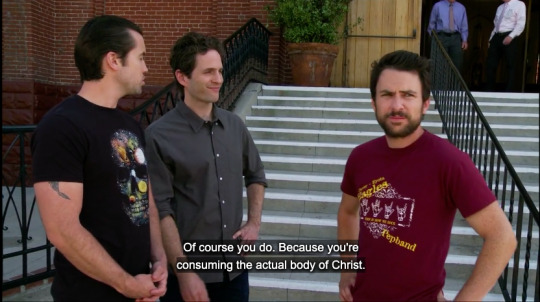
Anyway, at its core, as briefly stated in the bible verses above, communion is the act of "feeding" on Christ's body and blood as a tangible, visible reminder of what occured before, during and after, Jesus' crucifixion. And, the crucifixion itself is a symbol for many things, one of them being a victory over death and that "the world might be saved through [Christ]" (John 3: 17).
BUT! How does any of this stuff about communion relate to dennis takes a mental health day, you ask?
Well, when looking at the episode as a whole, it becomes clear that dennis utilises a fantasy to lower his blood pressure to a normal level. There are many debates currently about which avenue dennis' delusions fall under - whether it is actually a hallucination he's having, or a calming technique - but, in order to function better as a person dennis needs his blood pressure to be a stable number. And to do this he envisions himself eating another man's heart. And only then, after consuming the flesh of the Son of man (The CEO of tsuma), is dennis truly able to feel calm. Which means he is able to help the gang once again and can save them from whatever crisis they have gotten themselves into.
Christ urges his disciples to celebrate with him, despite knowing that he is going to die on the cross. Because when Christ is being sent to be crucified unwillingly, he presents a reminder of his love and protection through the figurative consumption of his flesh and blood. Christ's blood is then poured out and in return a new covenant (commonly used in theological terminology to mean an agreement or the creation of a new bond) is formed when he is resurrected, or reborn.
Dennis utilising the explicit imagery of eating a man's flesh just seems very poignant to me. dennis as a character views himself very much in the light of Christ, and is constantly referring to his physical and mental state to be akin to God - he is the Golden God after all. Therefore, his obsession with feeling in control and Godly, can be fed into with the motif of communion, crucifixion and renewal. So, i think it's interesting linking dtamhd to a biblical context, because of the layers and imagery.
BUT i need to stop rambling before my head explodes. So, I hope this was informative and I'm not well. (if you've read this far, thank you so much <3)
#iasip#it's always sunny in philadelphia#glenn howerton#dennis reynolds#iasip spoilers#sunny sweet 16#dennis takes a mental health day#dtamhd
13 notes
·
View notes
Text
Comedy, Prophets, and the Bible
Humor is an important facet of life. Why does it seem like biblical study is devoid of it?
Some of the subject matter in the Bible is not very funny. Slavery, Crucifixion, Being eaten by a whale and surviving.
I don't know if service has changed; but service was always a somber thing to do. You sit and listen to a preacher; and sit quietly in contemplation, instead of anything else you could be doing.
Quietly relearning the same three passages; and zoning out until the community notes.
That's not quite true, because some services have excitement, performance, and sometimes dancing. But those are the "wrong kind of services" to the more snooty religious people.
What point does religious mass serve?
The point of religious mass is serveral-fold. To teach people is one.
"Follow along with me as *we* read our Bibles."
Some chapters teach maths, important concepts such as "Why must we farm/work? Why must we learn new things? What's the dangers of the world? What is our history?"
These days mass religion has been forced into a role that only caters to the spirit.
Depending on how you interpret "Spirit", this includes "Comedy" and the spectacle that some churches are known for these days, despite forcing it into the singular lens of exactly how you should keep your spirits up.
To Stave off depression, as with the case with Covid shutting down the churches and the churches reasonably refusing.
Prophets and ministers also *used to* do a lot more than to cater to the spirit. There are chapters of the Bible dedicated to physical health and wellness of the people, of the farmland. One section is even dedicated to keeping your home free of mold.
These are not directly related to "spirit" but they improve a person's well-being so that they may be better able to interact with their community and be in "good spirits".
Heck, they even serve wine.
Joke; this is probably closer to an early dental hygiene thing--As alcohol could be known to Stave off halitosis, same way we use mouthwash today. (Yes a form of hippie-"new age" health trend.)
But these days?
Like we know of "Eastern medicine"; it works but does it work as well as what we have now?
And so Organized Religion is stuck in-between remembering the "old-ways" and being a conduit for "Spirit". And depending on how zealous your religion is; God and Morality before even that.
And in some cases; God is the *only* thing that matters. Despite these Minister's actual connection to, or lack of connection to their personal Deity, who they claim is the one true "Jehova" or "Yahweh".
"Ask not what God can do for you, ask what you can do for your God."
And so we see these drives to make our Nations an [insert religion here] Nation, that serves no purpose; not even God's.
Religion has a purpose; but religion has lost its way. And it's in the Bible, especially the good Christian Holy Bible; that we often see that Religion has lost its way.
We can read of the prophets and the "Son of God" as they fight against the mainstream religions of their days; why they needed to do so. We can see them fight against their governments, and why they needed to do so.
We can see the separation between church and state represented in the U.S. constitution and the groundwork laid by these texts and reasoning it was necessary.
So what is Religion?
Religion used to be something to make accessible to humanity the tools kept away from them by Industry and Government. Education, Mental and physical health care, services in which to aid the common man, and their communities, a voice of morality, and the teachings of something outside the physical world that we live in. Something we cannot reach while in the flesh.
But it has since been reduced to only the latter thing. Teachings of a God, only in such a way that the teachers believe; instead of as a being that helps all. The one true God, who knows and loves all. That thing that is unknown to humans as they live and breathe, but claimed to be known by those who teach it, and only them, as long as you pay a fee and are loyal.
4 notes
·
View notes
Text
Theological Implications of Jesus' Resurrection for Salvation
Jesus’ resurrection is an essential element in soteriology. In fact, every writer of the NT assumes that Jesus was resurrected from the grave and treat it as an event that took place in time and space. Paul wrote that Jesus “was raised on the third day according to the Scriptures” (1 Cor 15:4), that He was “the first fruits of those who are asleep” (1 Cor 15:20), and that “having been raised from…

View On WordPress
#Apologetics of Faith#atonement#Biblical Apologetics#Biblical Exegesis#Biblical interpretation#Biblical theology#Biblical Witnesses#Christian apologetics#Christian beliefs#Christian doctrine#Christian faith#Christian Hope#Christian living#Christian salvation#Christian theology#crucifixion#Divine Atonement#Early Christian Beliefs#Easter#Easter Theology#faith#gospel message#Historical Jesus#how important is the resurrection of Jesus#importance of Jesus resurrection#is resurrection important#is the resurrection essential to the gospel#Jesus Christ#Jesus resurrection#justification
11 notes
·
View notes
Note
Regarding your side B/side A tags - I don't think it's a salvation issue if i know side a Christians in same sex relationships. So like, there are some things to me where people say "I'm Christian but God isn't real" or you know, not that extreme but issues regarding the crucifixion often, where I'd be like hmm pretty sure you're not Christian then, like I'd say that's a fundamental issue. But then there are other issues like sexuality or swearing turns up a lot, where my take is like, you'll still be saved even if you engage in what I believe to be that sinful behaviour while being a Christian if you genuinely think it's not a sin and have properly considered it and all, it'll just be a whole bad brief moment in heaven. This is also how I think about like, denominational differences although that's not sin. There's gonna be Catholics and Prots in heaven and one group is gonna be SUPER awkward about the purgatory argument.
I mean I'm not a theologian so idk exactly, but basically I think there are some things I might be doing which are sinful and I've interpreted scripture wrong, like swearing! I swear all the time but I know that lots of Christians do think it's a sin. So I don't think I can really decide on matters like this which aren't like. Core beliefs. If it's a salvation thing or not. I hope that makes sense it was a little rambly and I know it seems like I'm hedging but I swear I'm not it just makes the most sense to me.
That makes perfect sense! Because the whole concept of any one denomination being completely correct is insane and anti-biblical. I just thought I’d ask cause as I said I’ve known a lot of side B Christians who won’t even view me as a real Christian because I came out of my year and a half fellowship with God and determined homosexuality wasn’t a sin, based on scripture and cultural stuff as o mentioned in my tags. But there’s also a greater majority who view it the same way as you, where it’s a sin that has the same capability of distancing you from God as any other.
#I hope this makes sense lol#I was just curious cause ik you were side b based on old posts#but I didn’t know your exact stance#christianity
4 notes
·
View notes
Text
“what is wanted are blindness and intoxication and an eternal song over the waves in which reason has drowned”
higgs-amelie is blind i am literally so fucking sure of it you have no fucking idea how certain i am of this, this is literally the one goddamn thing i’m so certain that it’s literally absurd
thus spoke zarathustra as main inspiration for death stranding
The Dawn of Day by nietzsche for DS2 .
the least studied of all nietzsche works

“Nietzsche de-emphasizes the role of hedonism as a motivator and accentuates the role of a "feeling of power." His relativism, both moral and cultural, and his critique of Christianity also reach greater maturity. In Daybreak Nietzsche devotes a lengthy passage to his criticism of Christian biblical exegesis, including its arbitrary interpretation of objects and images in the Old Testament as prefigurations of Christ's crucifixion.
Nietzsche in (93) acknowledges that a universe does not come from God or a creator but physics and science. The aphorism (93) begins from the question in the gospel of John (18:38). This interpretation and development of his thought were to prove errors in dogmatic teaching of Christianity that power and not divinity is the psychology of belief. “
6 notes
·
View notes
Text
[Faith Discussion] Catholic Friend's Comprehensive Perspective on Salvation, Faith, and Works
The Catholic friend argues against the doctrine of "faith alone," emphasizing that salvation in the Christian life is a process that involves both faith and works. Their perspective is grounded in Scripture, historical Church teachings, and the importance of apostolic tradition.
Faith and Works as Inseparable
The Catholic friend strongly believes that faith and works cannot be separated. They reference James 2:17-23, which clearly states that "faith by itself, if it is not accompanied by action, is dead." According to this view, faith in the biblical sense includes belief, but it must be demonstrated through actions. For them, true faith is living and active, always accompanied by good works.
Judgment According to Works
Citing Revelation 20:12, the Catholic friend emphasizes that people will be judged based on their deeds, not faith alone. They argue that this passage clearly shows that works are essential in the final judgment, reinforcing the belief that salvation involves both faith and works. This interpretation aligns with their broader understanding that salvation is a process that requires an active response to God's grace.
Historical and Apostolic Tradition
The Catholic friend places great importance on the teachings of the early Christian Church, particularly those upheld by the Catholic and Orthodox traditions. They argue that these churches, which trace their origins directly back to the apostles, have consistently taught that faith must be accompanied by works. They highlight Job 8:8, which calls for consulting the wisdom of past generations, and Galatians 1:6-12, which warns against deviating from the original Gospel message. This view underscores the importance of adhering to the teachings and traditions passed down through the centuries, which they believe have been guided by the Holy Spirit.
The Role of Baptism and Jesus’ Sacrifice
The Catholic friend acknowledges that Jesus' crucifixion offers salvation from original sin, but they also stress that baptism is necessary for purification and entry into the Christian life. They believe that baptism, along with living a life of good works, is crucial for maintaining one's relationship with God. While they recognize the centrality of Jesus' sacrifice in initiating salvation, they argue that this grace must be continually lived out through works to fully receive and sustain salvation.
Rejecting the Doctrine of "Faith Alone"
The Catholic friend rejects the notion that salvation can be attained through faith alone, viewing it as an incomplete and potentially misleading doctrine. They argue that such a teaching oversimplifies the Gospel and ignores the clear biblical mandate for works to accompany faith. They believe that a correct understanding of the Gospel requires acknowledging the necessity of works, as supported by both Scripture and the historical teachings of the early Church.
Consistency with Early Church Teachings
The Catholic friend is particularly critical of newer Christian denominations or movements that have adopted the "faith alone" doctrine. They argue that this interpretation is a modern development that contradicts the teachings upheld by the early Church for over 1,500 years. They emphasize that the Catholic and Orthodox traditions have maintained a consistent understanding of the relationship between faith and works, guided by the Holy Spirit as promised by Jesus in John 14:16-17. They see these newer interpretations as potentially heretical, as they deviate from the teachings passed down from the apostles and the early Christian communities.
The Catholic friend argues for a holistic understanding of salvation that integrates both faith and works, as taught by Scripture and the historical Christian Church. They believe that true faith is demonstrated through actions, and that salvation is a process that involves both belief in Jesus Christ and a life of good works. They caution against the "faith alone" doctrine, advocating instead for adherence to the teachings and traditions preserved by the Catholic and Orthodox Churches, which they view as the authentic continuation of the apostolic faith.
To provide a corrected perspective on salvation, faith, and works, let’s focus on a biblically grounded understanding while addressing misconceptions.
1. Faith and Works:
Salvation is by grace through faith alone. Good works are the fruit of genuine faith, not a requirement for salvation.
Ephesians 2:8-9: "For by grace you have been saved through faith, and that not of yourselves; it is the gift of God, not of works, lest anyone should boast." This passage clarifies that salvation is solely by grace through faith, not by works.
James 2:17: "Thus also faith by itself, if it does not have works, is dead." This means that true faith will naturally produce good works as evidence of its existence, not that works are necessary for salvation.
2. Judgment According to Works:
While believers are judged by their works, this does not determine their salvation. Works are evidence of faith and will be evaluated for rewards.
Revelation 20:12: "And I saw the dead, small and great, standing before God, and books were opened. And another book was opened, which is the Book of Life. And the dead were judged according to their works, by the things which were written in the books." This verse speaks to the evaluation of works for reward, not for the basis of salvation, which is through faith in Christ alone.
1 Corinthians 3:12-15: Paul speaks of the quality of each person’s work being tested by fire, indicating a judgment of works for rewards rather than salvation.
3. Historical and Apostolic Tradition:
While early Church teachings are valuable, they must be interpreted in light of Scripture. The core doctrine of salvation by grace through faith is clear in the New Testament.
Galatians 1:6-9: Paul warns against deviating from the Gospel he preached, emphasizing that the Gospel of grace through faith is the true message (v. 8-9). Early Church practices should align with this core message.
4. The Role of Baptism and Jesus' Sacrifice:
Baptism is a significant step of obedience following faith and symbolizes the believer's identification with Christ’s death, burial, and resurrection. It is not the means of salvation but an expression of faith.
1 Peter 3:21: "There is also an antitype which now saves us—baptism (not the removal of the filth of the flesh, but the answer of a good conscience toward God), through the resurrection of Jesus Christ." This verse indicates that baptism symbolizes the believer’s faith and commitment, not the actual act of saving.
Acts 16:31: "So they said, 'Believe on the Lord Jesus Christ, and you will be saved, you and your household.'" Faith in Christ, not baptism, is the means of salvation.
5. Rejecting the Doctrine of "Faith Alone":
The doctrine of "faith alone" (sola fide) is biblically accurate in that salvation is through faith alone. However, true faith will result in a life of good works.
Romans 3:28: "Therefore we conclude that a man is justified by faith apart from the deeds of the law." This supports the doctrine of justification by faith alone.
James 2:24: "You see then that a man is justified by works, and not by faith only." This passage must be understood as showing that works are the evidence of faith, not the basis of justification.
6. Consistency with Early Church Teachings:
Early Church teachings must be evaluated alongside Scripture. The consistent biblical message is that salvation is by grace through faith, and works are the evidence of that faith.
John 14:16-17: "And I will pray the Father, and He will give you another Helper, that He may abide with you forever—the Spirit of truth." The Holy Spirit guides believers into all truth, including the essential Gospel message of grace through faith.
Conclusion:
The biblical perspective on salvation emphasizes that it is by grace through faith alone (Ephesians 2:8-9). Good works are not a requirement for salvation but are the natural outcome of genuine faith (James 2:17). While works will be evaluated for rewards (Revelation 20:12; 1 Corinthians 3:12-15), they do not determine one's salvation. Baptism is an important act of obedience and public declaration of faith, but it is faith in Christ that saves (Acts 16:31; 1 Peter 3:21). Early Church teachings should align with the core biblical doctrine of salvation by grace through faith, with works serving as evidence of true faith.
#VerseOfTheDay#TruthOfTheDay#Jesus#Gospel#Bible#Church#Christianity#Theology#Technology#Grace#Purpose#Truth#ChatGPT#VerseGPT#Devotion#AI#DevotionAI
0 notes
Link
0 notes